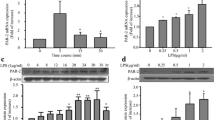Abstract
A 14-membered ring macrolide, erythromycin, acts not only as an antibacterial but also as an anti-inflammatory agent. We have previously reported that erythromycin modulates neutrophil functions and ameliorates neutrophil-induced endothelial cell damage through the action of cyclic AMP-dependent protein kinase (PKA) and nitric oxide (NO). We investigated the effect of erythromycin on human endothelial cell functions. Erythromycin enhanced intracellular calcium ion concentration ([Ca2+]i) of endothelial cells and NO release from endothelial cells. The enhancement of NO release from endothelial cells by erythromycin was abolished by addition of EGTA in the medium and was partially reduced by addition of H-89, an inhibitor of PKA. These results suggest that erythromycin enhances NO release from endothelial cells through the action of PKA and [Ca2+]i. In addition, constitutive NO synthase (cNOS) protein expression of endothelial cells was dose-dependently enhanced by treatment with erythromycin, which might also contribute to the enhancement of NO release from endothelial cells by erythromycin. The effect of erythromycin as an anti-inflammatory agent might be partially mediated through the enhancement of NO release from endothelial cells and the drug might be a useful tool for the investigation of cNOS of endothelial cells.
Similar content being viewed by others
References
Katahira J, Haruki K, Shibata Y: Stimulation of interleukin-1 and tumor necrosis factor production by oral erythromycin. Chemotherapy 39: 320–328, 1991
Goswami SK, Kivity S, Marom Z: Erythromycin inhibits respiratory glycoconjugate secretion from human airways in vitro. Am Rev Respir Dis 141: 72–78, 1990
Umeki S: Anti-inflammatory action of erythromycin. Chest 104: 1191–1193, 1993
Ichikawa Y, Ninomiya H, Koga H, Tanaka M, Kinoshita M, Tokunaga N, Yano T, Oizumi K: Erythromycin reduces neutrophils and neutrophil-derived elastolytic-like activity in the lower respiratory tract of bronchiolitis patients. Am Rev Respir Dis 146: 196–203, 1992
Ichikawa Y, Koga H, Tanaka M, Nakamura M, Tokunaga N, Kaji M: Neutrophilia in bronchoalveolar ravage fluid of diffuse panbronchiolitis. Chest 98: 917–923, 1990
Kadota J, Sakito O, Kohno S, Hara K: A mechanism of erythromycin treatment in patients with diffuse panbronchiolitis. Am Rev Respir Dis 147: 153–159, 1993
Mitsuyama T, Tanaka T, Hidaka K, Abe M, Hara N: Inhibition by erythromycin of superoxide anion production by human polymorphonuclear leukocytes through the action of cyclic AMP-dependent protein kinase. Respiration 62: 269–273, 1995
Mitsuyama T, Furuno T, Hidaka K, Hara N: Modulatory effect of roxithromycin on human neutrophil function. Res Exp Med 195: 301–307, 1996
Mitsuyama T, Furuno T, Hidaka K, Tanaka T, Abe M, Hara N: Inhibition by erythromycin of human pulmonary artery endothelial cell injury induced by human neutrophils. Respiration 64: 206–210, 1997
Beckman JS, Beckman TW, Chen J, Marshall PA, Freeman BA: Apparent hydroxy radical production by peroxynitrite: Implications for endothelial injury from nitric oxide and superoxide. Proc Natl Acad Sci USA 87: 1620–1624, 1990
Venyaminov SY, Baikalov IA, Shen ZM, Wu CSC, Yang JT: Circular dichroic analysis of denatured proteins: Inclusion of denatured proteins in the reference set. Analytical Biochemistry 214: 17–24, 1993
Moncada S, Higgs EA: The L-arginine-nitric oxide pathway. N Engl J Med 329: 20022012, 1993
Tamaoki J, Takeyama K, Chlyotani N, Sakai N, Yamauchi F, Takazawa T: Effect of roxithromycin on ciliary motility of rabbit tracheal epithelium in culture. Respir Circ 39: 481–485, 1991
Aoshiba K, Nagai A, Konno K: Erythromycin shortens neutrophil survival by accelerating apoptosis. Antimicrob Agents Chemother 39: 872–877, 1995
De Tongi P, Cabrini G, Di Virgilio F: Cyclic AMP inhibition of fMet-Leu-Phe-dependent metabolic responses in human neutrophils is not due to its effect on cytosolic Ca2+. Biochem J 224: 629–635, 1984
Graier WF, Groschner K, Schmidt K, Kurovetz WR: Increases in endothelial cyclic AMP levels amplify agonist-induced formation of endothelium-derived relaxing factor (EDRF). Biochem J 288: 345–349, 1992
Fernandes PB: The macrolide revival: Thirty-five years after erythromycin. Antimicrobic Newslett 4: 25–34, 1987
Author information
Authors and Affiliations
Rights and permissions
About this article
Cite this article
Mitsuyama, T., Hidaka, K., Furuno, T. et al. Release of nitric oxide and expression of constitutive nitric oxide synthase of human endothelial cells: Enhancement by a 14-membered ring macrolide. Mol Cell Biochem 181, 157–161 (1998). https://doi.org/10.1023/A:1006894301389
Issue Date:
DOI: https://doi.org/10.1023/A:1006894301389




